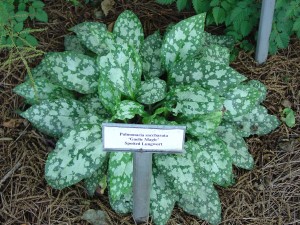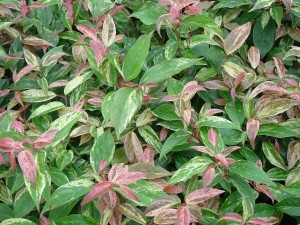In June 2012 plant pathologists at the Connecticut Agricultural Experiment Station have confirmed a natural infection of pachysandra in the landscape by boxwood blight (Cylindrocladium pseudonaviculatum), the boxwood blight fungus. The infection originated from recently installed balled and burlapped (B&B) boxwood plants. A plant inspector in Fairfield, CT noticed that an established bed of pachysandra […]
Archive for the ‘Ground cover’ Category
‘Brigadoon’ Hypericum Wakes Up a Garden Bed
The bright chartreuse (almost golden) foliage Brigadoon St. John’s wort (Hypericum calycinum ‘Brigadoon’) can brighten up almost any dull garden spot. This Euro-Asian ground cover thrives in any well-drained soil under full to partial sunlight (USDA zones 4-7). Full sun may burn the summer foliage in zone 7. ‘Brigadoon’ grows 12 to 16 inches tall and spreads […]
‘Lady Francis’ Ivy Wakes Up A Shady Patch
On a recently trip to the Ohio State University Horticultural Gardens in Columbus, I discovered ‘Lady Frances’, a relatively tame miniature ivy. The American Ivy Society classifies Hedera helix ‘Lady Frances’ as non-invasive, and it received the first “Ivy of the Year” award in 2001. It grows slowly and works as a ground cover or topiary […]
‘Helene Von Stein’ Lamb’s Ear Is More Behaved
Stachys byzantina is a dense gray woolly perennial ground cover, which earns it the common name “lamb’s ear”. ‘Helene Von Stein’ is the single best cultivar, displaying larger leaves, and is more heat and humidity tolerant. Sometimes listed as ‘Big Ears’, it rarely produces flowers which may tarnish its lovely silvery gray foliage appearance. Lamb’s ear grows […]
Sacred Lily (Rohdea) Brings Good Fortune
Depending on where you garden, Sacred Lily (Rohdea japonica) is either an evergreen or herbaceous perennial groundcover. It is slow growing and prospers in a moist shady woodland environment. Small clumps of long, strap-like leaves emerge from an underground crown to about 15” in height. Foliage is comprised of 18 inch long strap- like leaves […]
Pulmonarias: Wonderful In The Shade Garden

Although my multi-year addiction for hostas has never waned, I remain equally passionate about the lungworts (Pulmonaria spp.). Lungwort is also called Bethlehem sage and Jerusalem sage. Their uniquely splotched or variegated foliage wakes up a dark patch in any shade garden. Lungworts are planted as ground covers and for color accents. In early spring (March), lungworts send up […]
Winter Jasmine Rising
Is the worst of winter behind us? Winter jasmine (Jasminum nudiflorum) is often confused with forsythia shrubs which bloom 3-4 weeks later in the spring. This hardy winter blooming vine from China frequently blooms in late February and March when daytime temperatures climb into the mid-50s for a week or more. Evening chilling temps down into the […]
Try Microbiota Instead of Ground Junipers
Summer Foliage of Microbiota Microbiota (Microbiota decussata) goes by numerous names including Russian arborvitae and Siberian cypress. This tough customer hails from Siberia, and quite cold hardy to -40 F. In the northern U.S. its lacy evergreen foliage turns brown in the dead of winter. Here in the Southern Appalachian region, microbiota prospers in cooler parts of zone 6 […]
Doghobble for Shady Landscape Areas

Drooping doghobble or fetterbush (Leucothoe fontanesiana) is native to woodland areas in the Southern Appalachian region (USDA zones 6 and 7). Doghobble is a tall ground cover, averaging 3 – 4 feet in height. The long gently arching evergreen branches display a rambling nature, best reined in with hand pruning as needed. White fragrant flowers, […]

 Posted in
Posted in 

